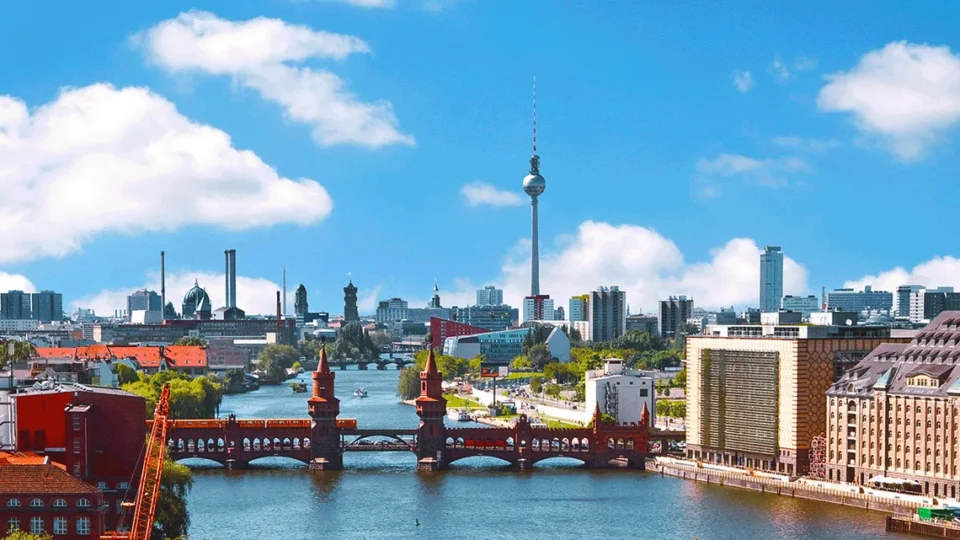Berlin is one of the most interesting tourist destinations. It embodies centuries of history of defeats and victories, the status of the capital of three states, and the cultural and economic achievements of the German people. To get to know the unique attractions of the city, you need to dedicate quite some time. But if you only have 2 days, you should plan a route in advance that allows you to see the main cultural and historical sites of the legendary city. This article recommends what to see in Berlin in 2 days on your own.
First Day
Today, let’s walk through the most significant and popular places in the city. We’ll soak in the atmosphere and take some bright and memorable photos. We recommend choosing comfortable shoes and clothing. The route is very busy.
Alexanderplatz
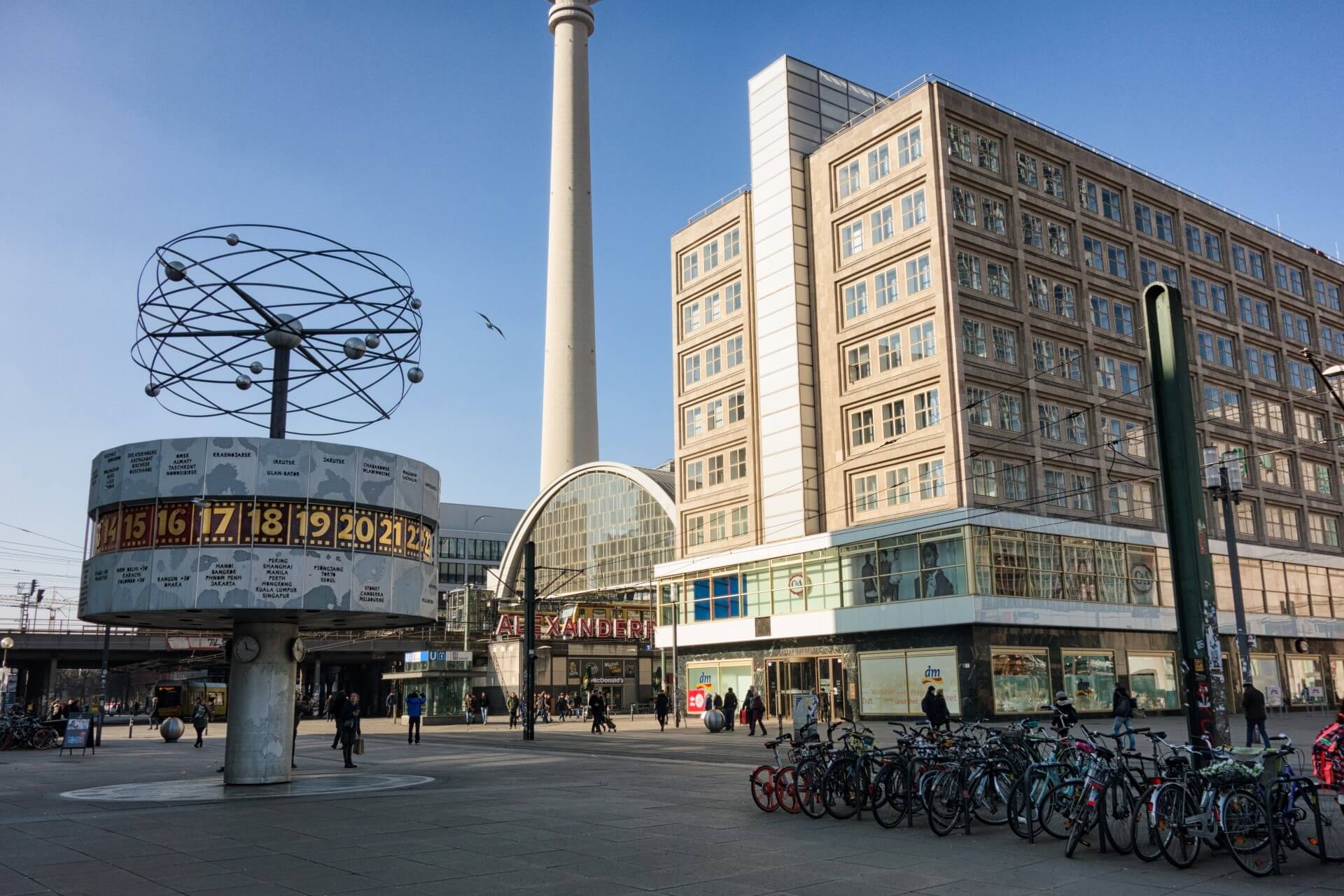
If you’re expecting to see attributes of old Europe on the central square, you’ll be disappointed. Alexanderplatz, named after the visit of Russian Emperor Alexander I (1805), is a typically modern square today. The huge space impresses with its size and the grandiosity of its structures.
You won’t see medieval palaces and castles here. Historical upheavals have changed the face of what was once a small market square. Only the Red Town Hall and St. Mary’s Church remain from the old buildings – authentic symbols of past eras. The 20th century almost completely changed the historical place, increasing its size by four times.
Today, Alexanderplatz symbolizes the economic power and cultural prosperity of the German capital. Famous skyscrapers like the TV Tower, Park Inn Hotel, and the “Alex” shopping center – products of socialist modernism in architecture – are impressive in their appearance. Recently, a super-modern 39-story residential building with a luxury hotel on the first floor “grew” here. Alexanderplatz is a favorite meeting place for Berliners, a significant transportation hub, and a popular tourist destination.
Berlin TV Tower
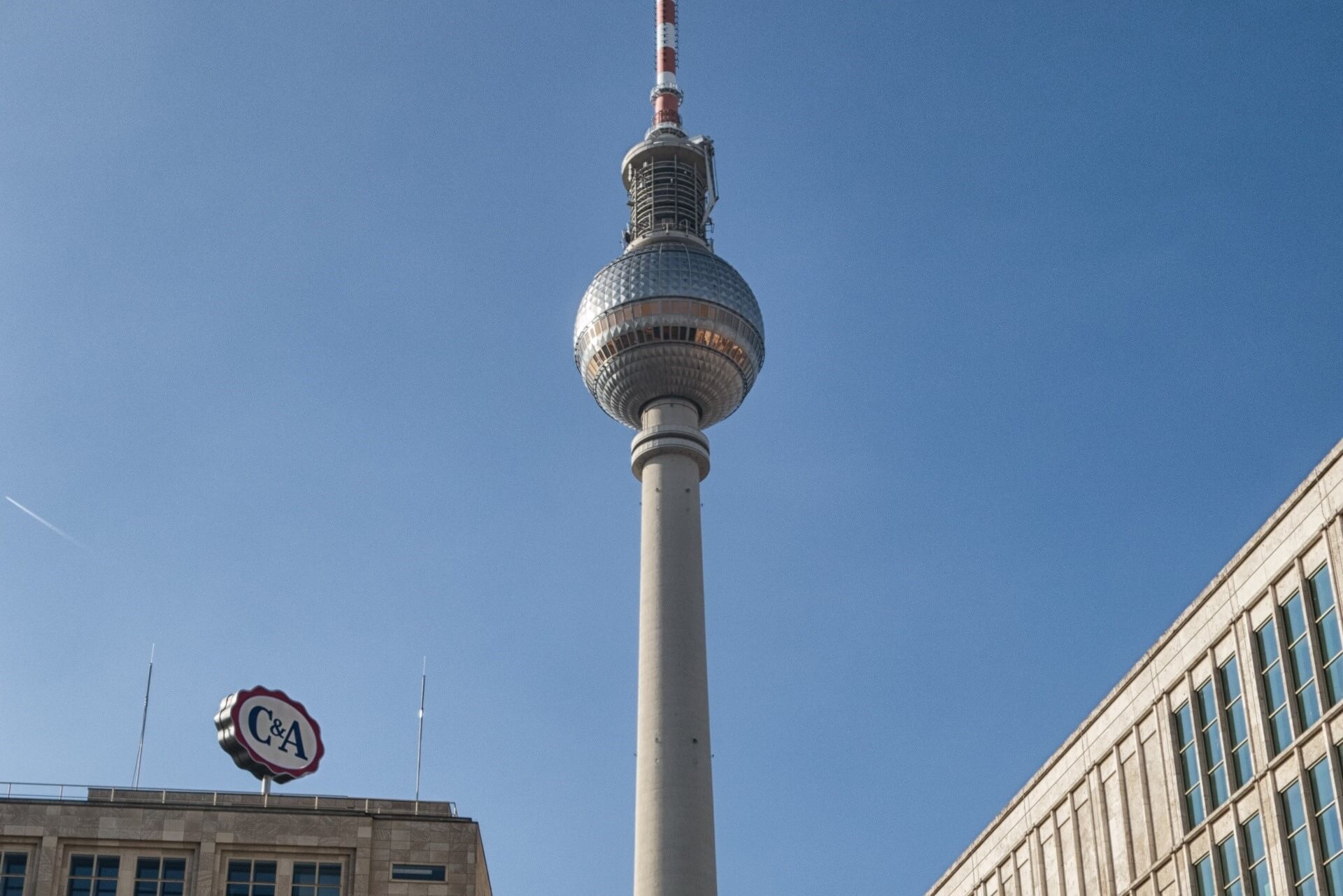
This unique high-rise structure, built in socialist Germany, has not lost its futuristic symbolism even today. The Berlin TV Tower (height: 368 meters) still looks like an object of architectural modernism. A group of talented architects carried out the grand project. Instead of the estimated 30 million marks, 200 million were spent, and in October 1969, the building was put into operation.
The result of the collective effort justified the expenses – the high-rise construction masterpiece remains a popular tourist attraction. The interest is not only in the tower’s appearance and height. Visitors are fascinated by the technology of the sliding method used to erect such an extraordinary structure. At a height of 200 meters, there is a huge metal sphere with a diameter of 32 meters. It was assembled on the ground from separate plates and installed by a crane attached to the tower’s trunk. The tower is topped with an antenna (height: 118 meters), assembled from 4-meter conical segments.
Several entrances to the tower daily receive hundreds of tourists, who ascend to the observation deck in seconds on silent high-speed elevators. The deck is located inside the sphere at 204 meters, offering a charming panorama of the city. There is also a wonderful restaurant (on a rotating platform) with German national cuisine.
St. Mary’s Church
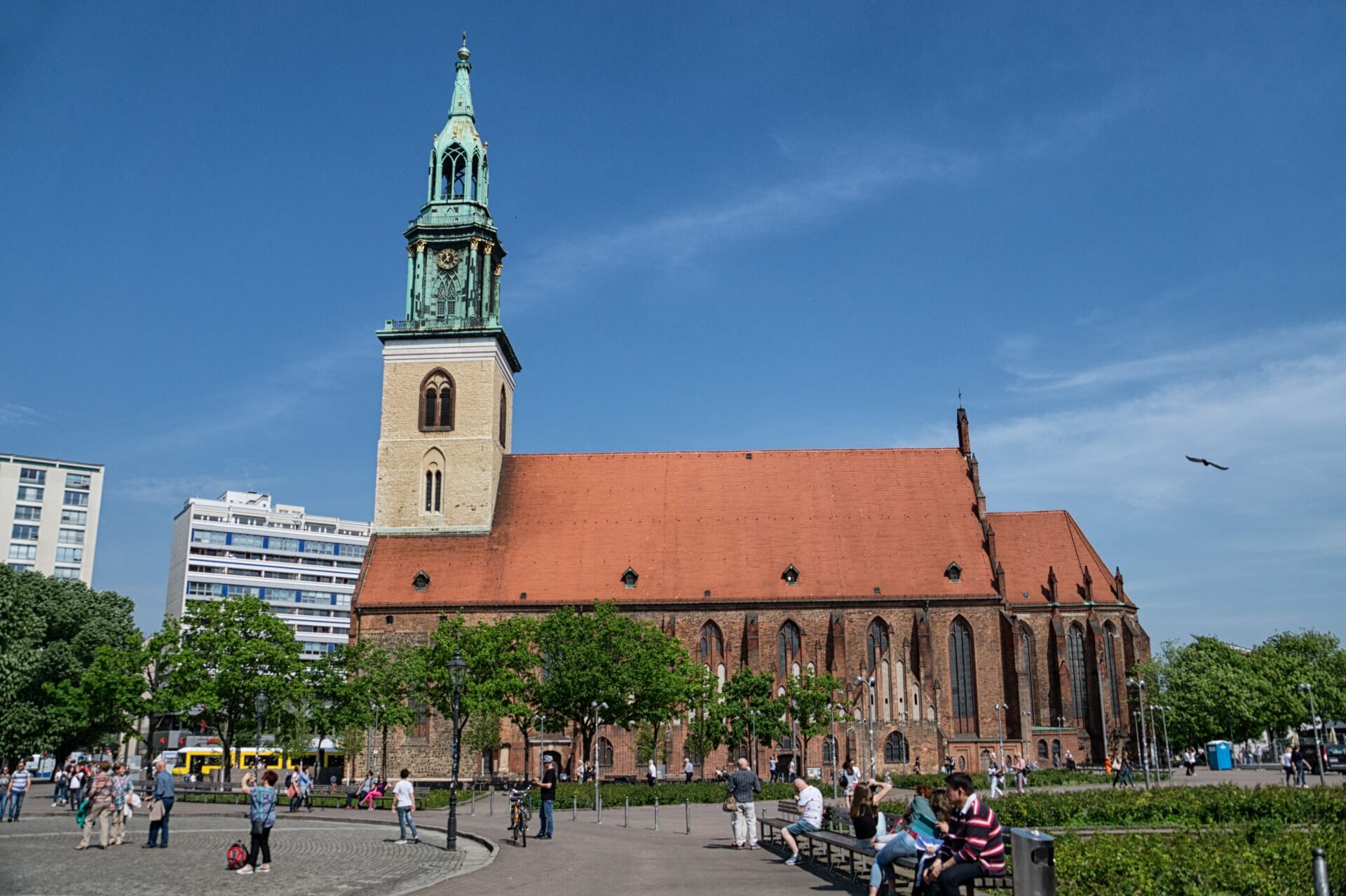
Among the modern buildings on Alexanderplatz is an “island” of antiquity – St. Mary’s Church. Its Baroque-Gothic appearance, a reminder of the historical past, captivates with its authenticity. Built in the 13th century from bright red bricks in the Brandenburg Gothic style, the church has undergone architectural changes.
After a fire in the 17th century damaged the tower, it was restored and adorned with Baroque elements. In the 18th century, the tower was given a neo-Gothic appearance. St. Mary’s Church remains the only old building on the square, drawing a stream of tourists. The church has become a kind of museum where one can see the authentic atmosphere of the Middle Ages.
The interior decor impresses with numerous decorations in various styles. The sculpture of “John the Baptist” surrounded by angels, the Baroque altar, the ancient fresco “Dance of Death,” and the Gothic baptismal font leave an indelible impression. The silver organ, played by the hands of the genius Bach, attracts and fascinates everyone. One cannot help but be enchanted by the magnificent singing of the church choir during Sunday services and feel the high spirituality.
Neptune Fountain
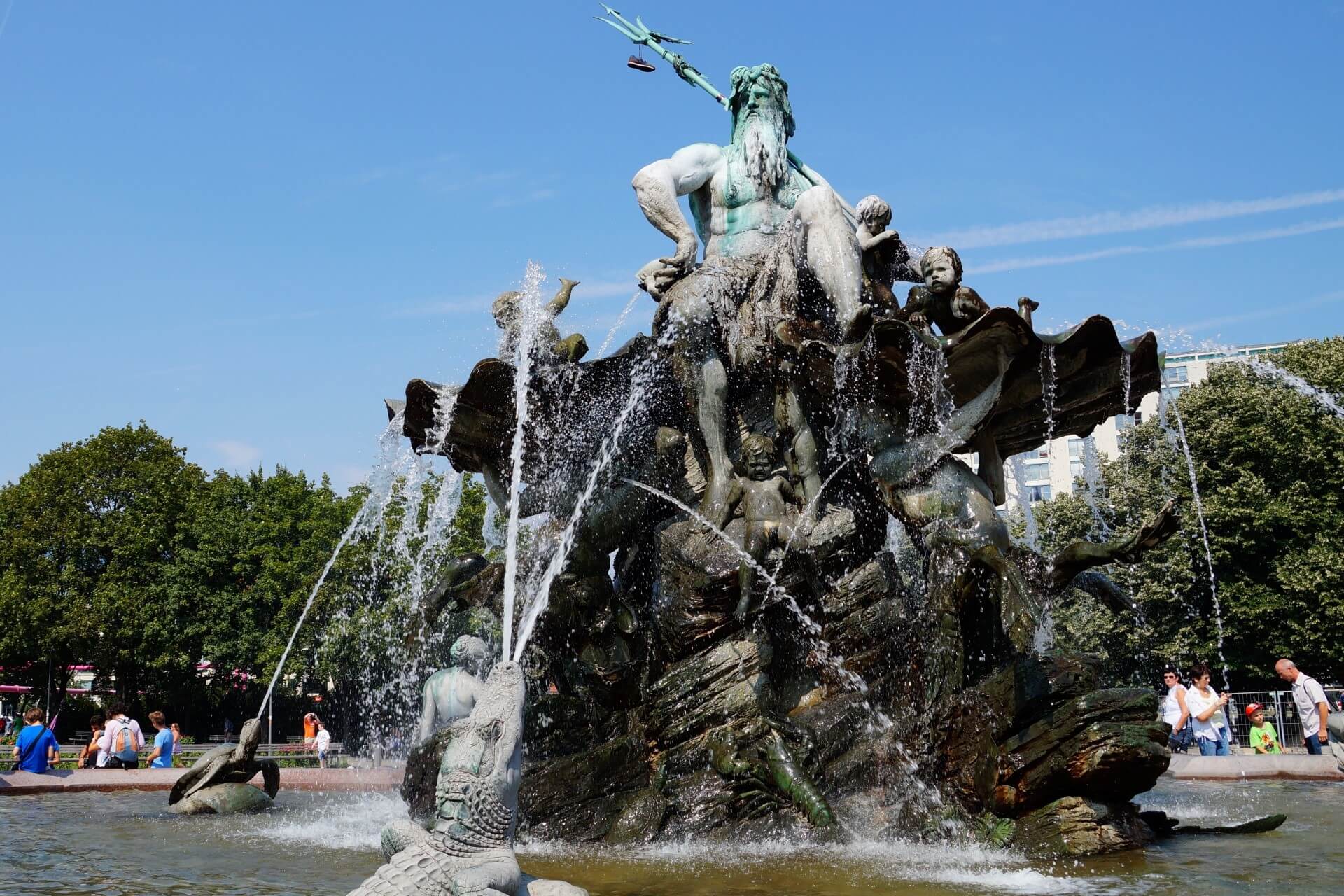
Near the TV Tower is a masterpiece of 19th-century fountain architecture – the Neptune Fountain. It is one of the main attractions and serves as a symbol of the revival not only of Berlin but of all Germany. The fantastic structure in the antique style was created by sculptors Schinkel and Begas as a gift to Kaiser Wilhelm II (1891). It was installed in front of the monarch’s winter residence on Palace Square.
Like many architectural monuments of the city, the fountain-monument was significantly damaged during the 1945 bombing. Wilhelm’s Palace, destroyed to the ground, was demolished in 1951, and the Neptune Fountain was stored and subsequently restored. The unique cast sculptures were restored to their original state, and the monument was installed in a new location – near Alexanderplatz.
The fountain’s appearance impresses with its dimensions. The diameter of the four-sided basin with rounded edges is 18 meters, and the height (excluding the trident) is 10 meters. The basin’s bottom and rim are made of granite. In the center of the fountain’s basin is an improvised rock with Neptune, the lord of the seas, seated on his shell throne, surrounded by children. Around the pedestal are numerous sculptures of sea creatures. Four bronze female figures allegorically represent the main rivers of Germany. There are always many people around “Neptune.”
Red Town Hall
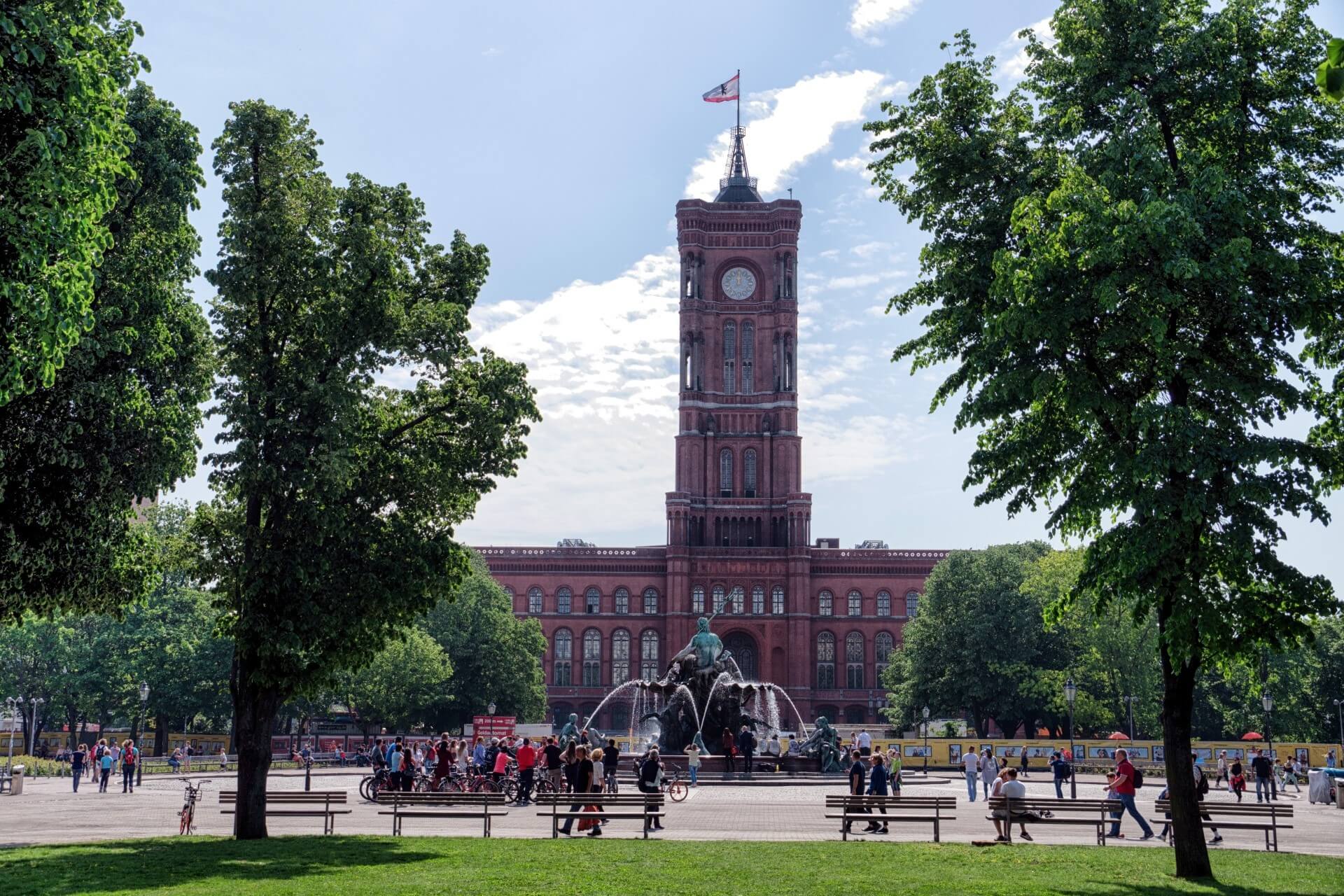
The unusually bright and beautiful Red Town Hall building impresses with its strict yet pompous architecture. Its exterior combines two styles – Renaissance and neo-Gothic – giving the structure a majestic appearance. The red unburned brick was ideal for realizing Wesemann’s project (1861-69). Like many structures, the Red Town Hall has been restored multiple times and supplemented with new elements.
Between the first and second floors, the facade is adorned with the frieze “History in Stone” (1979), depicting the stages of the German capital’s development. The mosaic window above the main entrance of the town hall is of great interest. A magnificent clock tower crowns the central portal. There are 300 steps leading to its top, where an observation deck is located. Massive figures of eight bears – symbols of the famous German Ascanian dynasty – are installed around the roof’s perimeter.
Today, almost all official meetings and business gatherings are held in the Column and Coat of Arms halls of the Red Town Hall. The well-furnished office of the mayor is also located here. Tourists can see the grand interior beauty only twice a year (January and August) during the “Long Night of Museums” festival. The red carpeted stairs, white columns with golden capitals, and luxurious furniture are awe-inspiring.
St. Nicholas’ Church
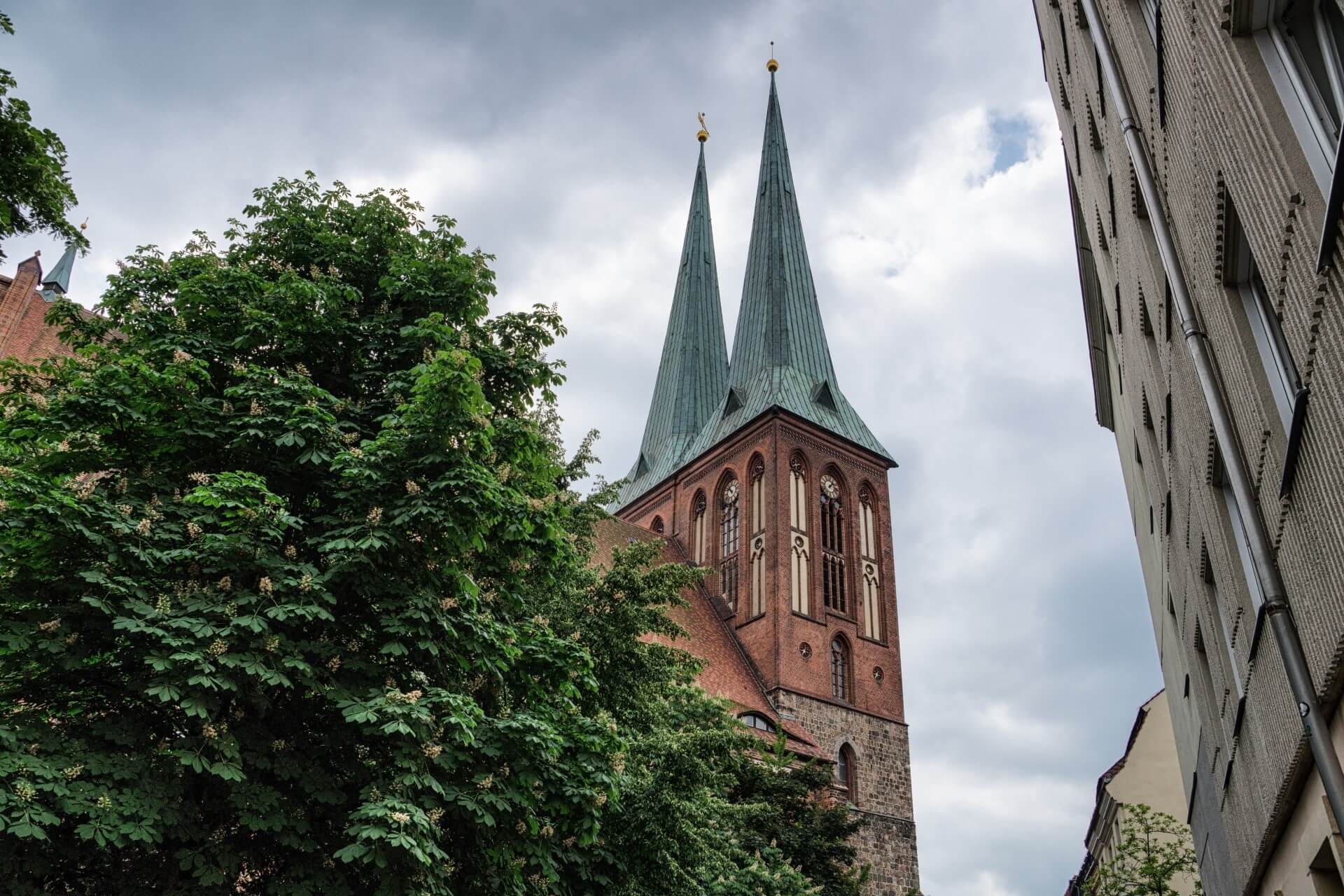
The oldest church (early 13th century) adorns the eponymous historic quarter of the city. It was built near the intersection of the Spree River with an international trade route and was initially a three-nave basilica with a cross. Later, it was rebuilt into a hall church in the Gothic style with a richly decorated altar and a tower on top. The Berlin Bakers’ Guild sponsored the work.
In the 19th century, during a two-year reconstruction, the church’s facade was transformed into a neo-Gothic style, adding another tower symmetrically to the first. In 1938, the historical and religious-architectural monument became state property. Church services ceased from that time. Some church artifacts of genuine artistic value were transferred to St. Mary’s Church.
Despite the severe bombings of 1945, the sanctuary’s powerful walls withstood, but the church remained in a semi-ruined state for a long time. Meticulous restoration work began in 1981 according to authentic drawings and plans. A new element was added – a carillon with 41 bells. Now it houses a branch of the Brandenburg Museum with artifacts from the 13th-14th centuries and a concert hall for organ music.
Ephraim Palace
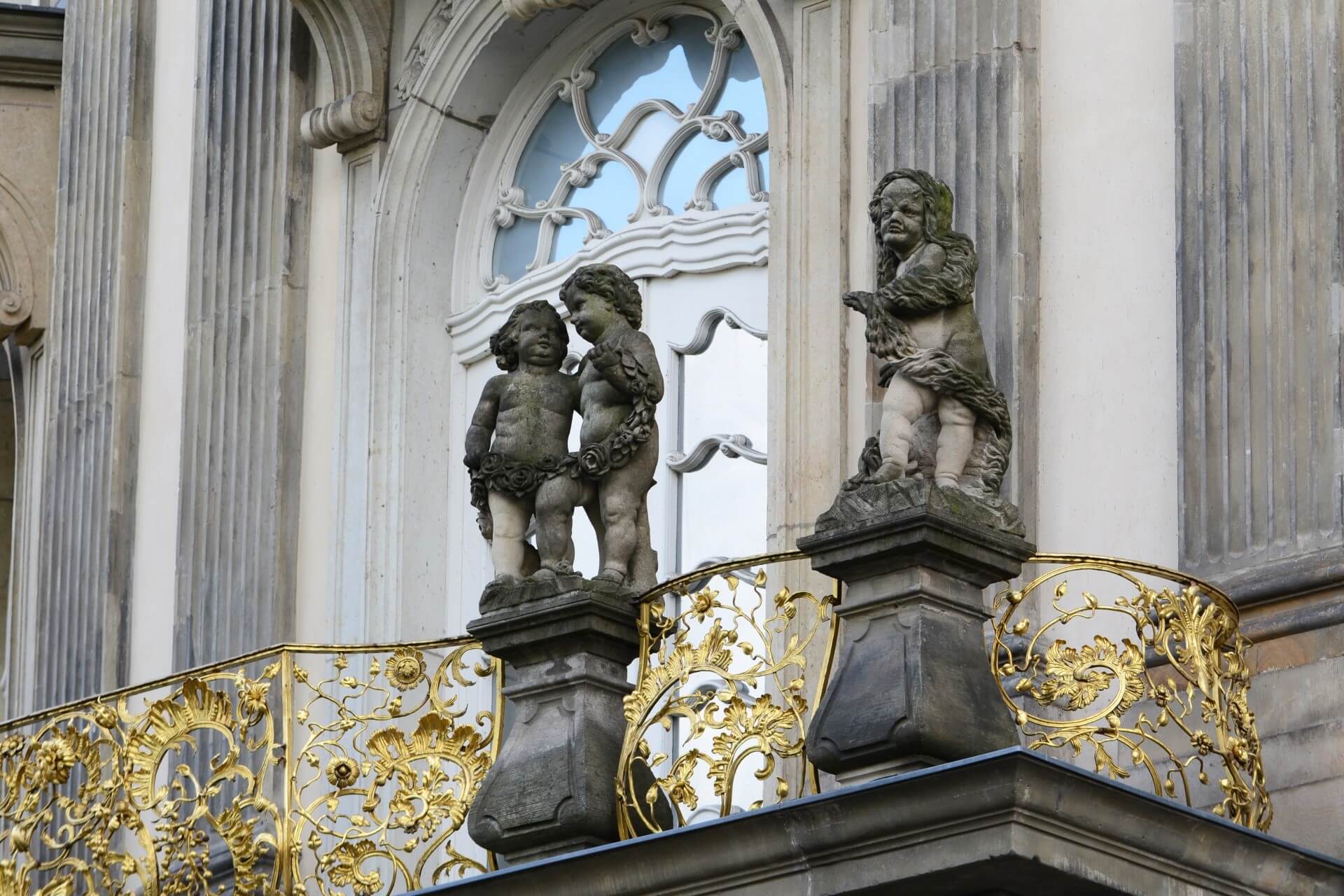
The astonishingly beautiful and elegant architecture of Ephraim Palace is a vivid testament to the careful and reverent attitude of the German people towards their past and its symbols. Built at the end of the 19th century, the palace belonged to a wealthy merchant and banker, Prussian Jew Ephraim. Enjoying the special favor of King Frederick II, the banker received permission to build a building in the prestigious Mitte district.
A true architectural masterpiece, like a Phoenix, rose from ruin in the 1980s. The beautiful four-story building, executed in the Rococo style, was almost demolished during the construction of the Mühlendamm Bridge in 1936. Fragments of the facade, walls, and decorative elements were taken to West Berlin, where they remained for a long time.
The decision to restore Ephraim Palace was made seven years before Berlin’s 750th anniversary as part of restoration work in the historic Nikolaiviertel quarter. Thanks to the efforts of architect F. Klinger, the magnificent example of Rococo architecture was given a second life in its original form. Today, the palace impresses with its exquisite gold decor, whimsical asymmetry of structures, and majestic columns and statues.
Berlin Cathedral
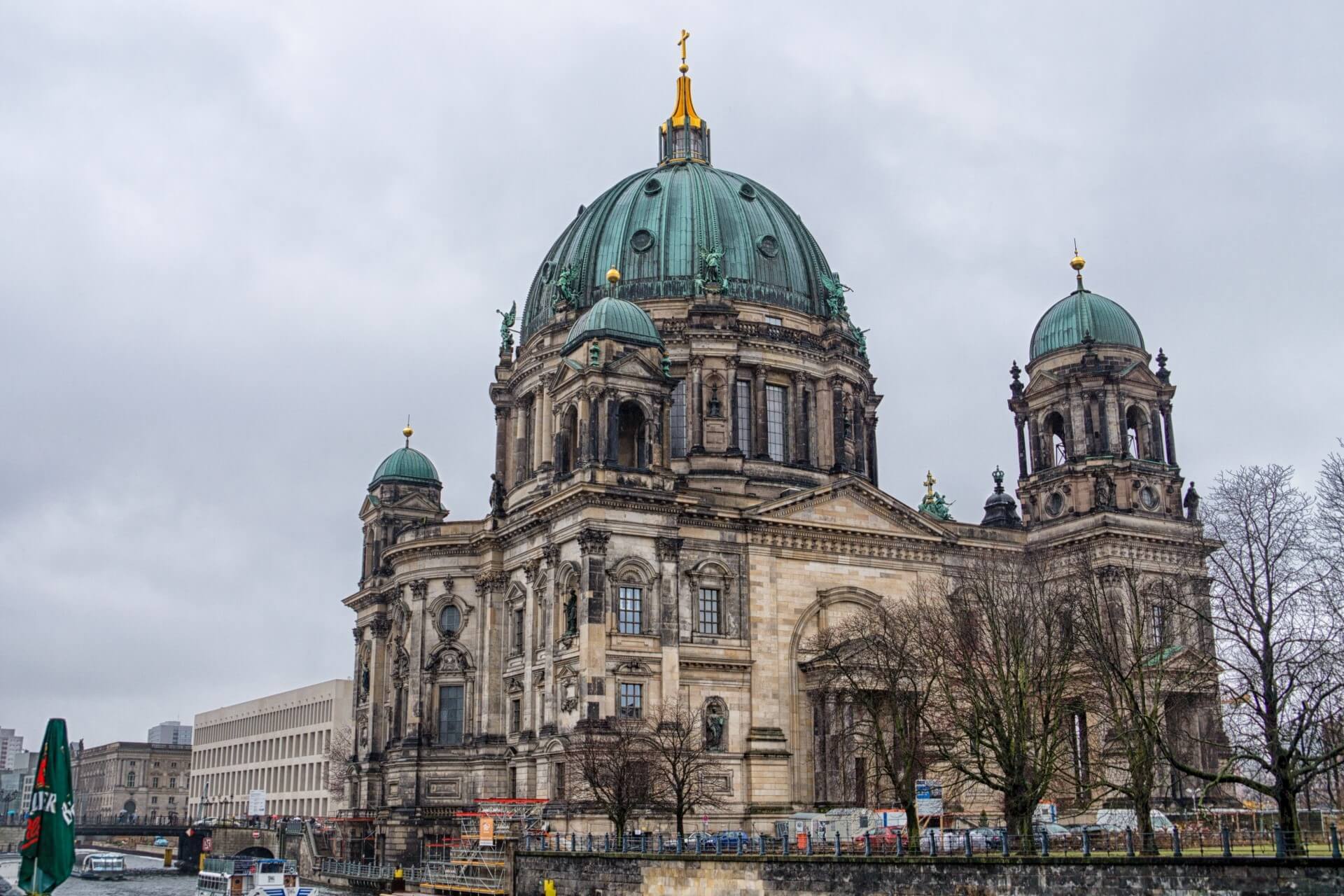
On Museum Island (Spreeinsel) is the famous Berlin Cathedral – the largest Protestant church in Germany. It took 11 years to build the magnificent church, intended to become the main congregation of Lutherans in Europe. The Baroque appearance of the Protestant church is bright and lush, devoid of traditional asceticism.
Numerous stucco ornaments, sculptures, and columns adorn the church’s exterior. Majestic copper domes crown the architectural work of art. Inside, you feel spatial and spiritual freedom. Everything here is also bright and beautiful: stunning stained glass windows, paintings of biblical scenes, and the carved patterns on the pulpit.
After the war, the cathedral was reconstructed for many years. As a result, its height decreased by six meters, but it still impresses with its irresistible beauty. An observation deck (a favorite spot for tourists) is located in the central dome. An organ by the famous master Sauer is installed in the hall. The church also houses the family tomb of the Hohenzollern dynasty.
Lustgarten Park
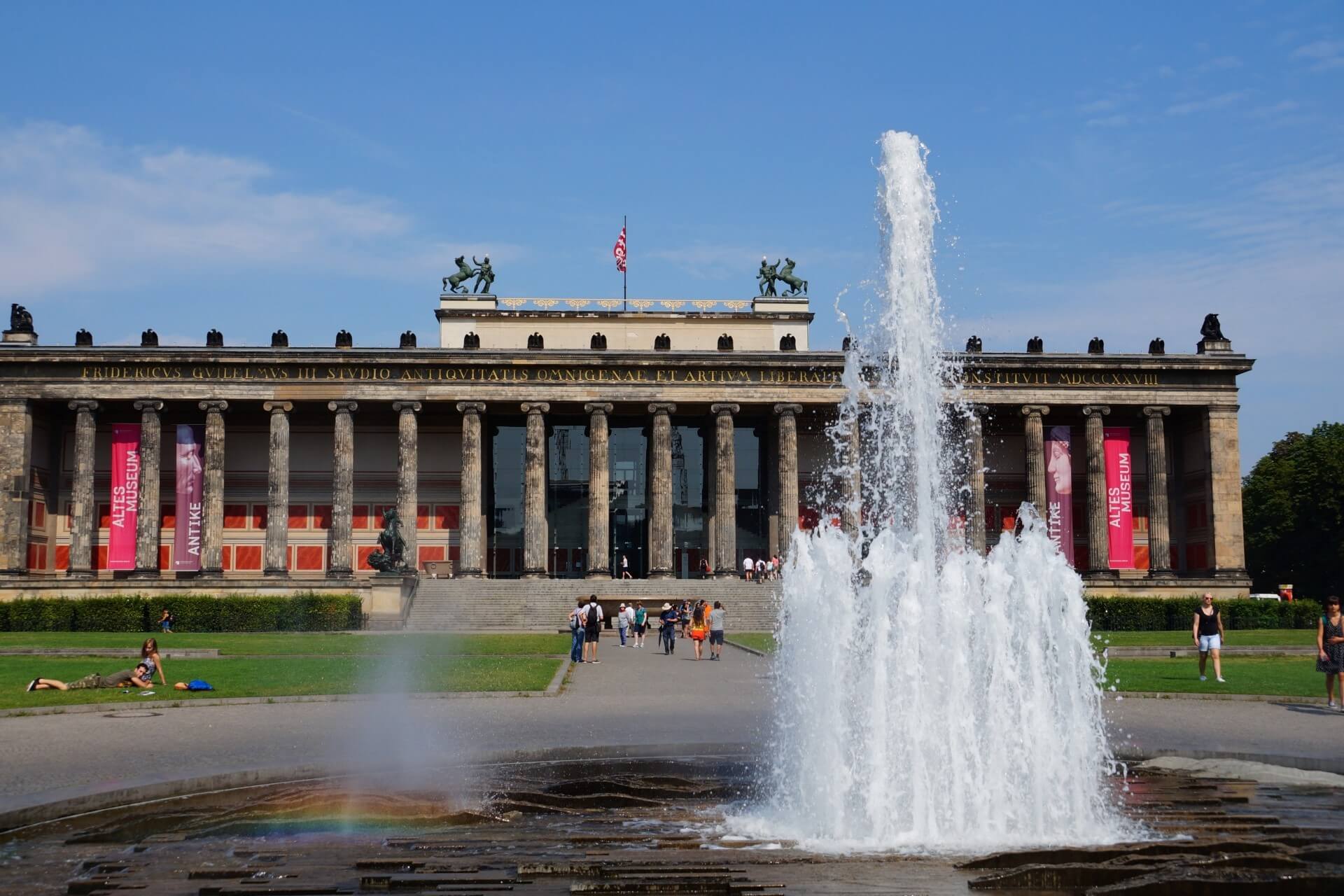
In front of the Cathedral is the wonderful Lustgarten Park, restored in 1946. In the 17th century, the palace farm of the Brandenburg Elector was located here. Later, various mass events were held. Under King Frederick I (1713), a military parade ground with a sandy cover was arranged. The 19th century gave the former parade ground a different look. Under the direction of famous architect Schinkel, the Old Museum building was erected, and a grand fountain operating on a steam engine was built.
This was a real technical breakthrough, impressing everyone, as did the fountain itself. But later, a sculpture of Frederick III was installed in its place. The war destruction did not spare the park, practically destroying everything in it. Only in 1998 did restoration work on Lustgarten begin. Now, this beautiful place delights citizens and tourists with its picturesque beauty. Intricate fountains, original landscape designs, and a charming English-style garden enchant and soothe.
German Historical Museum
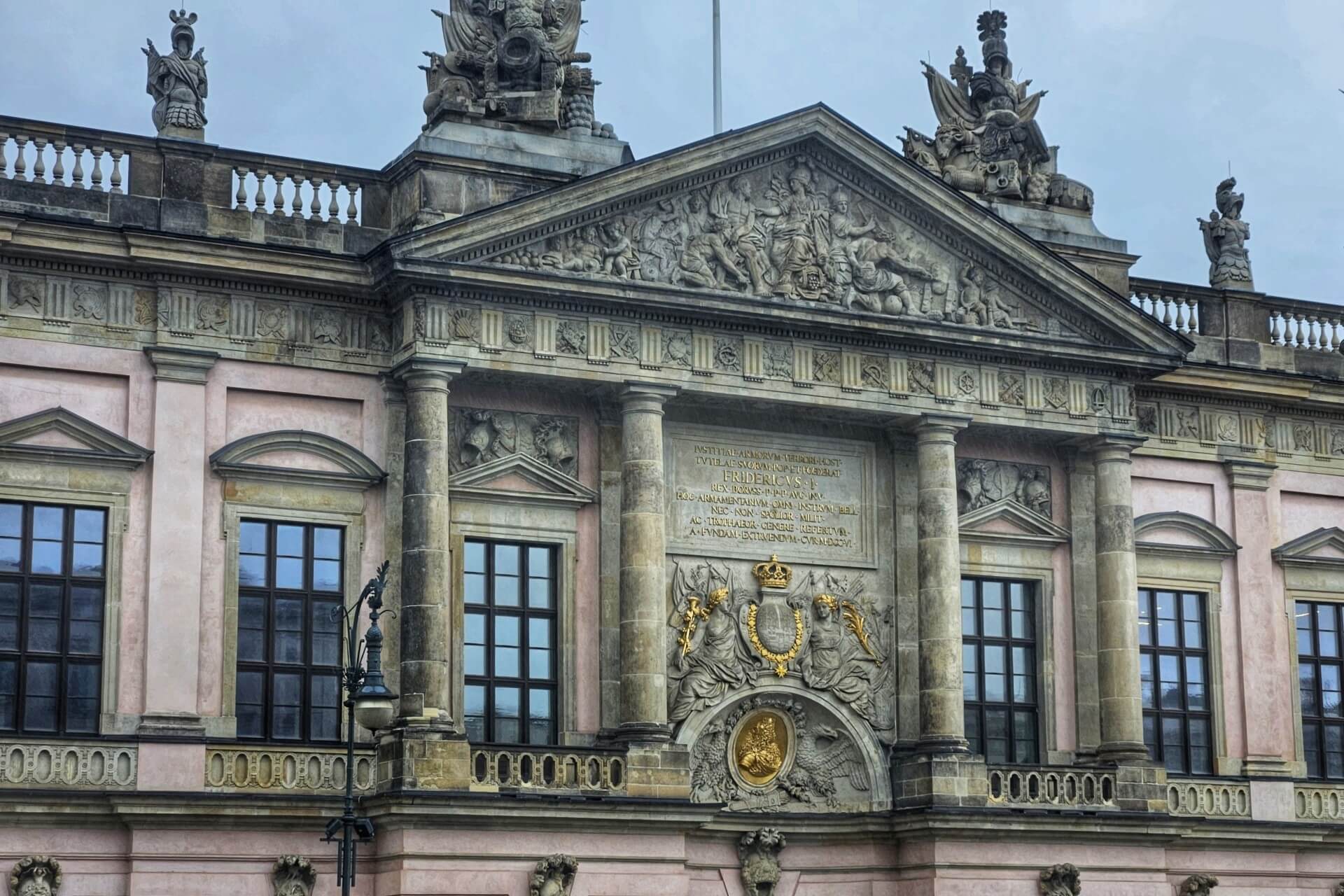
The German Historical Museum was opened in the Reichstag building in honor of Berlin’s 750th anniversary (1987). In the GDR, a similar museum was located in the Zeughaus – an old building of the Prussian Royal Arsenal. After Germany’s reunification in 1990, the two museums (one in the Reichstag and the other in the Zeughaus) merged into one grand institution – the unified German Historical Museum.
The oldest arsenal building underwent a long reconstruction (1994-2003). Built in the 18th century in the Baroque style, it was once restored after the Napoleonic Wars in the “Schinkel Classicism” style (named after architect Schinkel). This is a true architectural masterpiece, captivating with the expressive beauty of its exterior, which cannot fail to be admired.
The interior of the Zeughaus is equally impressive with its diverse exhibits illustrating all stages of the state’s development and decline. The history from primitive settlements to the present day unfolds before visitors. Temporary exhibitions are organized in the new modern-futuristic building made of glass and steel.
Old National Gallery
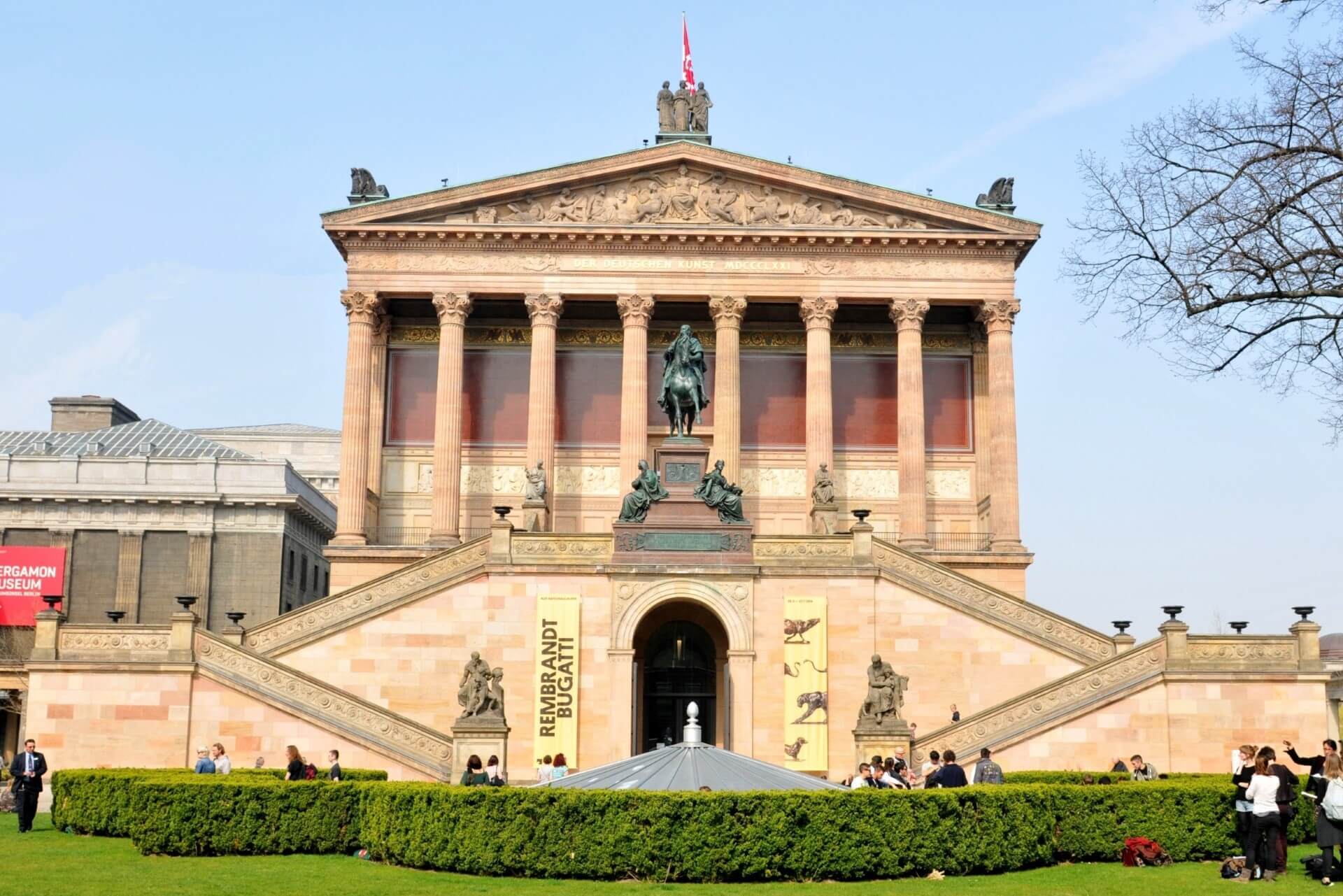
A temple of artistic works – this is how this cultural and educational institution can be described. The Old National Gallery was opened in March 1876 on Museum Island. The magnificent building with a grand entrance and elegant colonnade indeed resembles a temple. The first collection of artistic exhibits was a set of 250 paintings donated to the gallery by I. Wagner.
Like all significant city objects, the National Gallery building was heavily damaged during the bombings, remaining roofless for three years. After restoring the roof and cosmetic repairs, the museum opened to visitors in 1950. The collection of paintings reflects all directions of painting from classicism to contemporary abstract art.
After the country’s reunification, it was decided to conduct a major renovation of all the halls and the facade of the unique building. The renovated Old National Gallery opened in December 2001. Spacious, bright halls with chic decor are arranged to a high modern standard. Paintings by Manet, Cézanne, Waldmüller, Hasenclever, Degas, and other great artists captivate the eye and soul.
Pergamon Museum
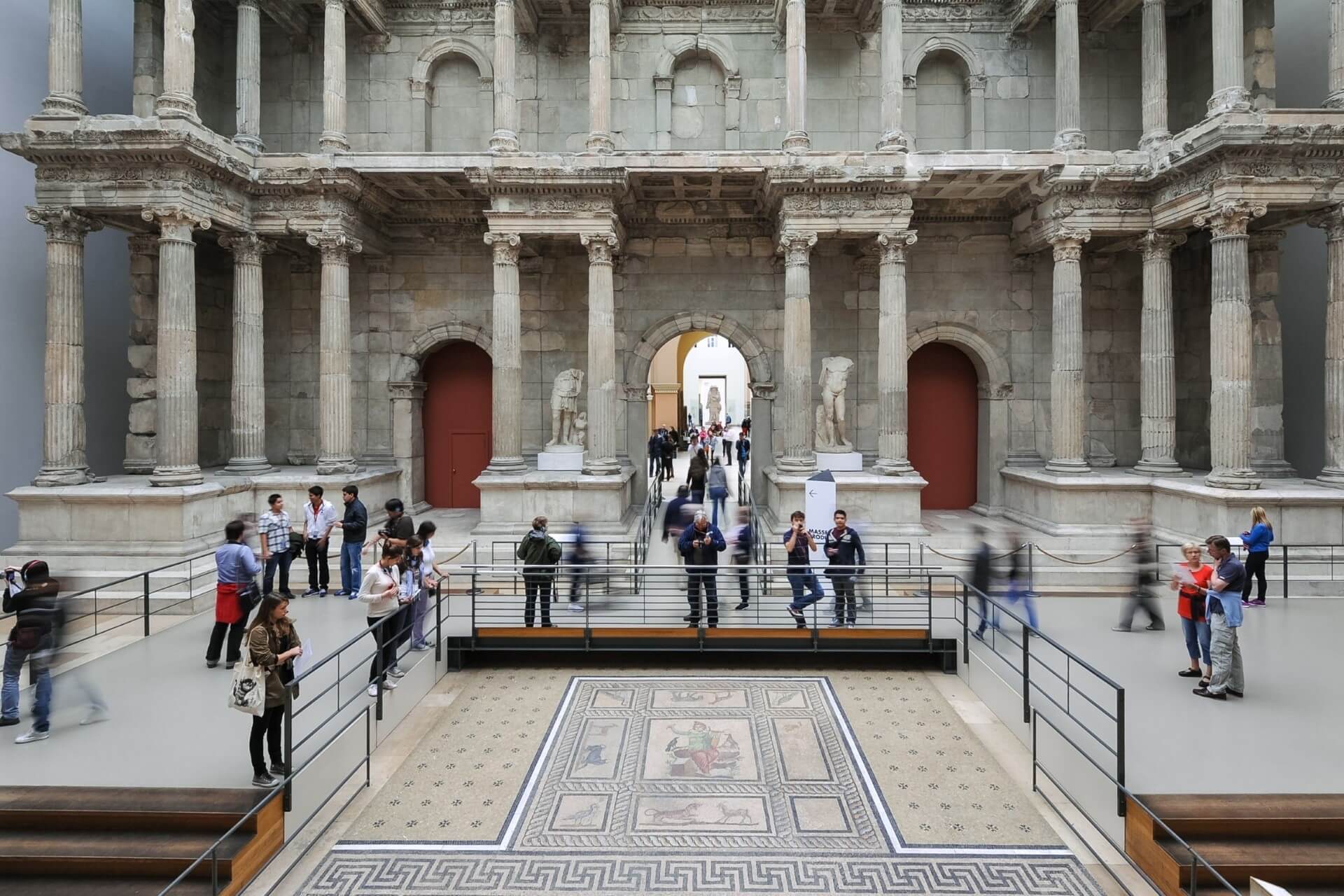
One of the most interesting institutions on Museum Island is named after the ancient city of Pergamon, located in Asia Minor. The reconstruction of Pergamon (129 AD) during the reign of Roman Emperor Hadrian is presented in the museum’s “Panorama” exhibition. All the exhibits found by archaeologists represent ancient art from various countries. Here are the Market Gate of Miletus, the Pergamon Altar, the Ishtar Gate from Babylon, and fragments of the facade of the Mshatta Palace.
Essentially, the Pergamon Museum is a complex of three museums: Classical Antiquities, the Near East Museum, and the Museum of Islamic Art. The “Pergamon” is currently undergoing another reconstruction, but most exhibitions are open to visitors. You can see the Miletus Gate, Ishtar, Babylon, and Mshatta friezes. The Pergamon Altar is closed for restoration of the facade.
Second Day
The first day of sightseeing has ended. It seems there is nothing more to be surprised at, that you have seen the most interesting things, admired the churches, the palace, and the museums. But don’t rush to conclusions – the vast city can still amaze you with its squares and extraordinary world-famous objects.
Reichstag

In the heart of Berlin stands the monumental and majestic building that has witnessed triumphs and the inglorious defeat of fascism. This architectural and historical monument is a significant symbol not only of Berlin but of all Germany. It took ten years to build the grand structure intended for the German parliament – the Reichstag, now the Bundestag.
The building regained its original purpose only in the 1990s after the country’s reunification and Berlin’s status as the capital. The monumental beauty of the Reichstag, after major restoration, once again captivates and impresses tourists who actively visit the German Parliament. They are attracted not only by the majestic appearance of the object but also by its legendary history.
A captivating factor is the presence of a glass dome at the top, housing an observation deck (height: 40 meters). The dome, installed during the restoration, is a modernist project by British architect Foster. In the center of the unusual structure stands a large cone with 30 rows of mirrors reflecting sunlight into the parliamentary hall. You can learn many interesting details during a tour.
Brandenburg Gate
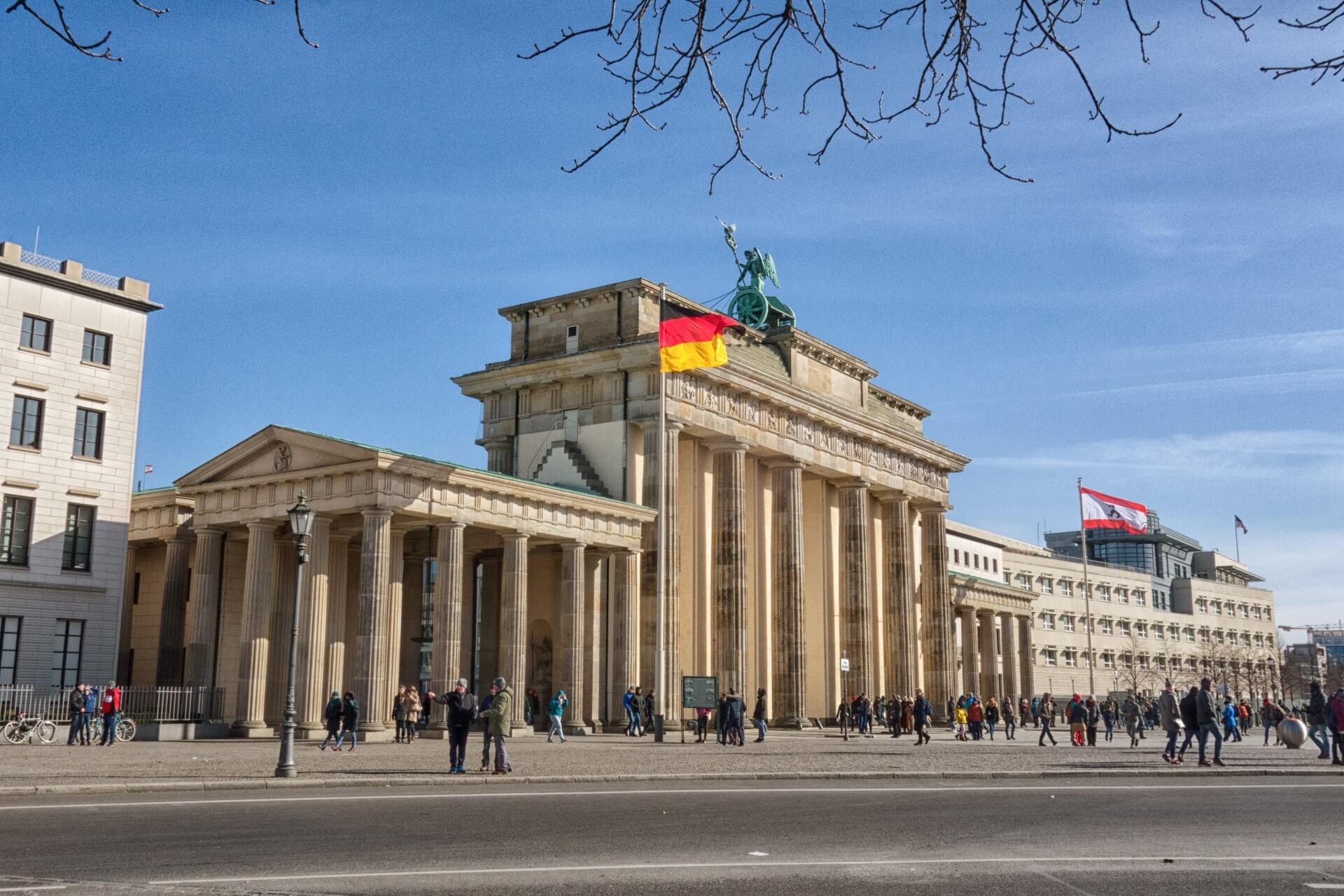
One of the most famous landmarks, the Brandenburg Gate, is an example of ancient Greek-style architecture. This majestic structure was created under Emperor Frederick William (1788-1791) as a connecting element between two parts of the city. However, history’s turn made it a symbol of Berlin and the state’s division (1961) when the Berlin Wall was erected.
The height of the architectural monument, designed by Langhans, is 26 meters, and its width is 11 meters. Six massive Doric columns support the gate’s portico. Atop it stands a classical quadriga with four horses driven by the goddess Victoria. During Napoleon’s invasion, the quadriga was taken to Paris as a war trophy (1806) and returned eight years later. In honor of this, architect Schinkel adorned the composition with an iron cross topped with an eagle.
In the Nazi era, the Brandenburg Gate was a place for marches, parades, and processions. After the bombings in 1945, the remarkable monument was restored in 1956, and five years later, the Berlin Wall was erected. It isolated access to the gate for 27 years. The wall’s demolition made the unique landmark a symbol of the country’s reunification.
Gendarmenmarkt
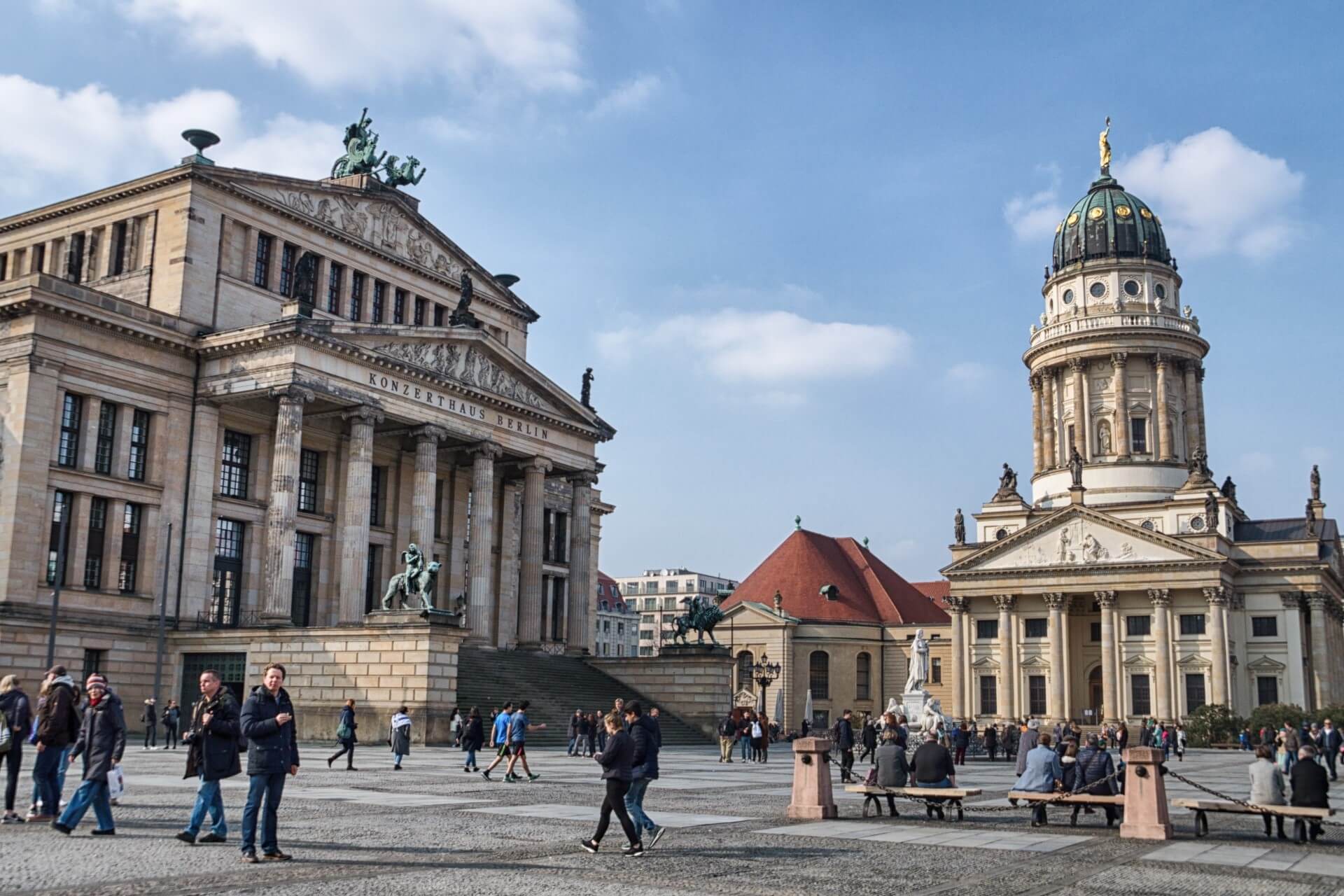
It is unlikely that you will find a more beautiful place than Gendarmenmarkt Square, with its long history. Founded in the 17th century as a market esplanade under Elector Frederick III, it has repeatedly changed its purpose and name. When the French Guard stables and a guard post were located here (1736-73), the square was named Gendarmenmarkt.
Under the orders of Frederick the Great, the stables were demolished, and a theater building was constructed, later replaced by the National Theater. Today, the third building on this site is the Concert Hall (1817-1821). The sculptures of Schiller and the four Muses (Lyric Poetry, Drama, History, Philosophy) remind of the former theater.
The two domed towers with circular colonnades are the undeniable architectural adornments of Gendarmenmarkt. They differ from each other with gilded sculptures crowning the domes. The figure of Triumphant Virtue stands on the tower of the German Church, while Triumphant Religion is on the French Church. Overall, the entire architectural ensemble of the square is a magnificent historical and cultural monument.
Checkpoint Charlie
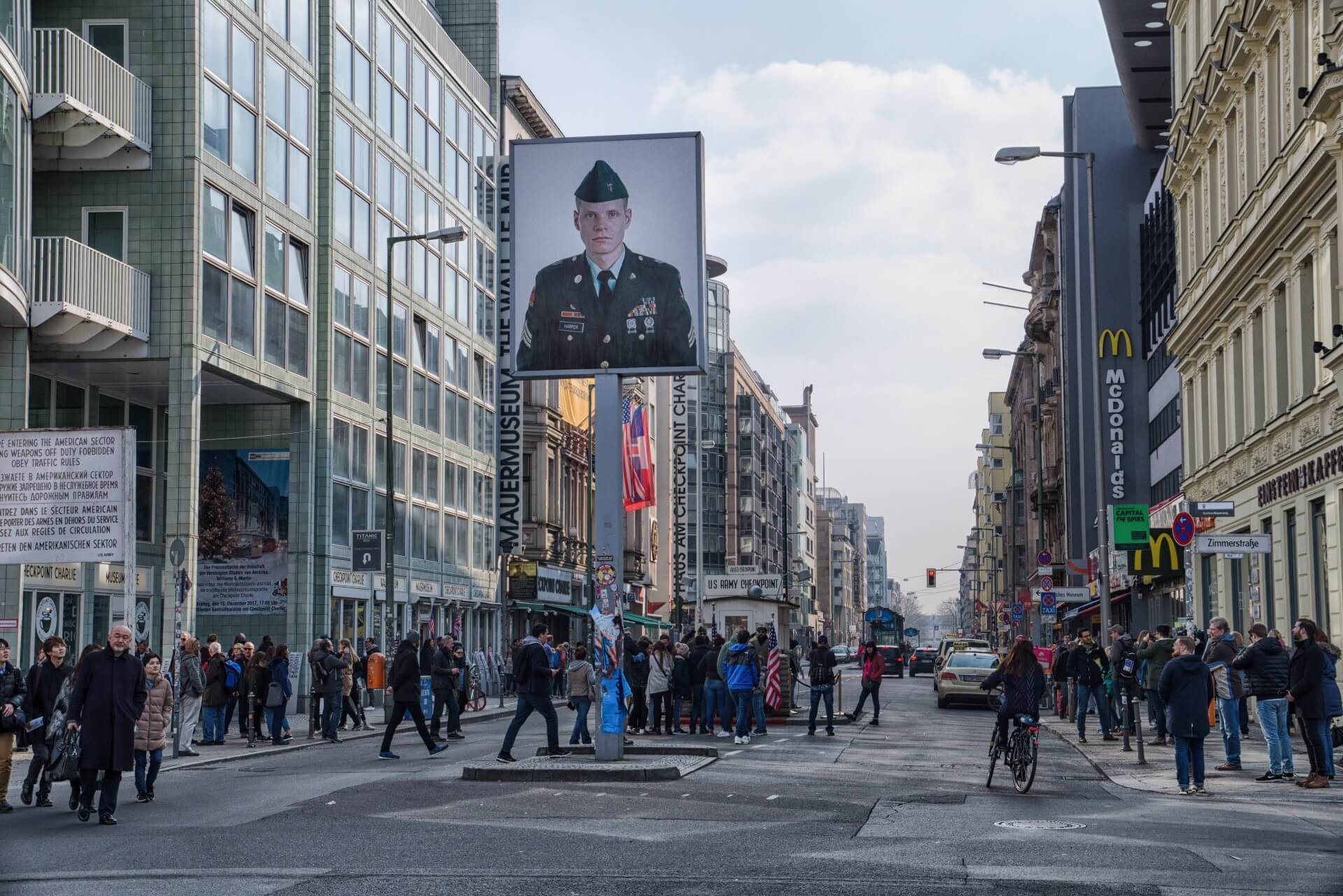
A unique museum that exists only in Germany is located where the checkpoint regulating relations between West and East Germany, divided by the infamous Berlin Wall in 1961, once stood. The museum’s exhibitions display archival documents, photos, items, and equipment illustrating the 28-year history of the confrontation.
Photos capture images of guard towers, bunkers, and signal devices. Documents tell about numerous defectors, of whom 1,500 people died. The “Berlin Wall Mile of History” exhibit shows moments of spy and agent exchanges. Artist Thiel’s installation tells the story of the country’s difficult period.
Films about the wall’s destruction, the people’s jubilation, and reconciliation are shown. The “From Gandhi to Walesa” exhibition portrays the worldwide struggle for human rights without violence and death. “Checkpoint Charlie,” a symbol of the contradiction between two political powers, is hugely popular with tourists.
Berlin Wall Memorial
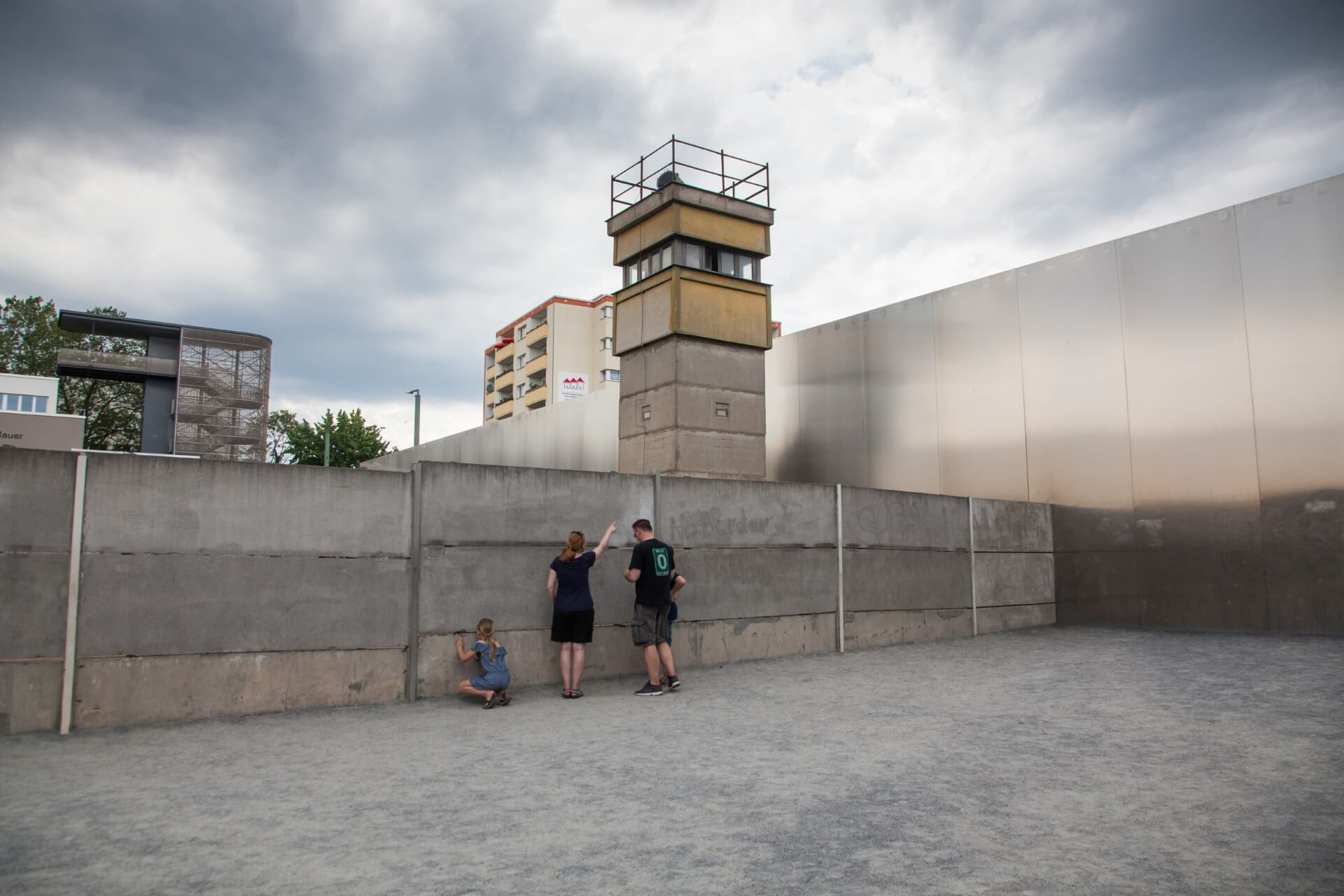
Another symbol of Germany’s historical split is captured in the Berlin Wall Memorial. The 163-kilometer concrete wall, erected in the summer of 1961, separated people, families, and friends for 27 years. Over these years, almost 75,000 people were convicted by the authorities of both countries for attempting to cross the wall, and over 1,000 were immediately shot. When East Germans were allowed to cross the border with special visas in 1989, they stormed the wall. In just a few days, nothing was left of the concrete barrier; its fragments were sold to private collectors. A few years later, even Berliners couldn’t precisely determine where the historic structure had stood. Noticing the tourists’ interest in this location, the government decided to restore the section of the wall where most illegal crossings to West Germany had taken place.
Collectors were actively buying back slabs with graffiti left by West German artists. An 800-meter section of the wall was reassembled, becoming the foundation of the Memorial. Out of 300 guard towers, only three remain, but they vividly complement the former border’s image. The gallery displays many unique historical photos and paintings, as well as Soviet memorabilia. The real atmosphere of the recent past is recreated, maintaining a growing interest.
Potsdamer Platz
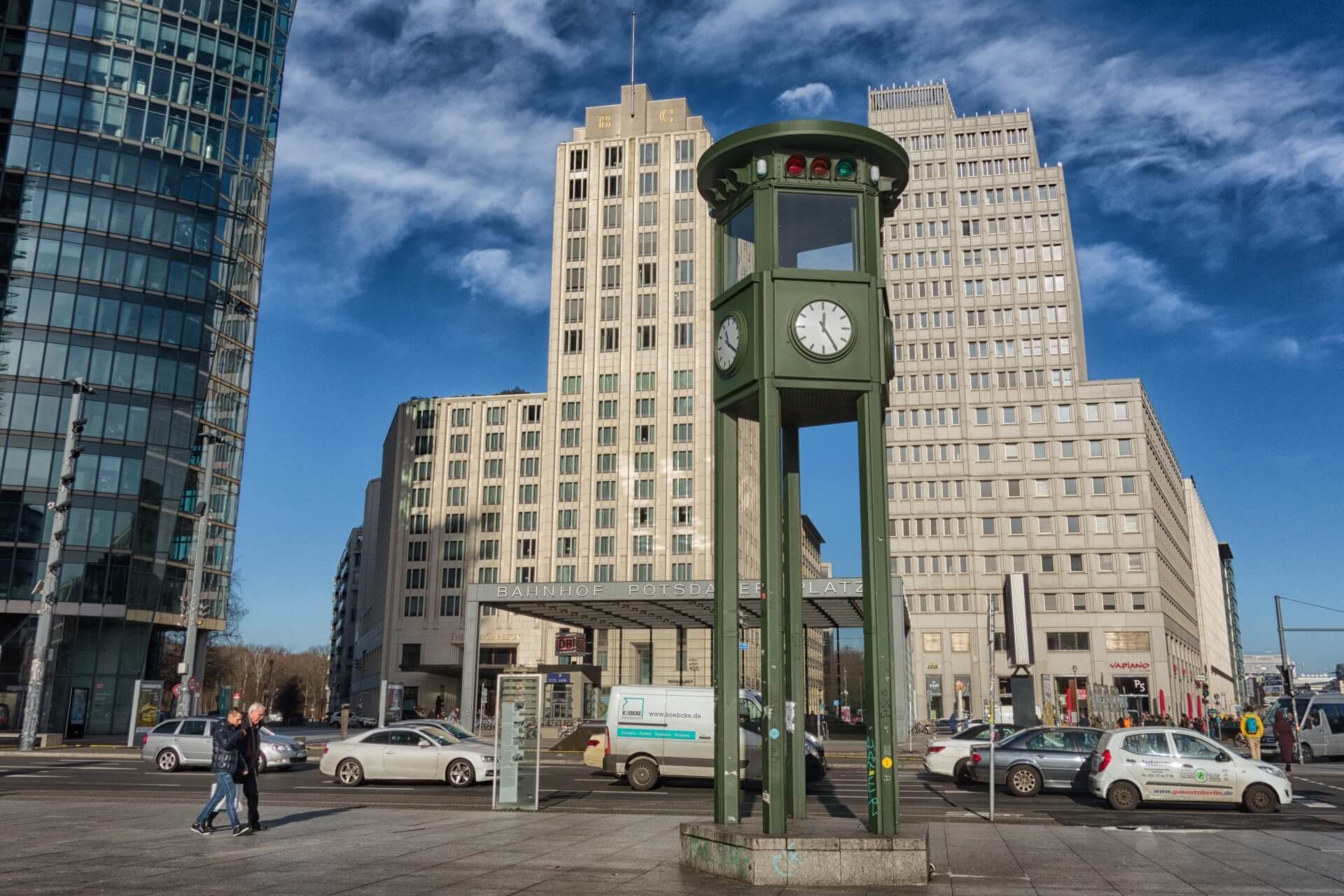
While the Berlin Wall Memorial embodies the past, Potsdamer Platz represents the rapidly developing present. Not long ago, this area was a wasteland left after the Wall’s destruction. In 20 years, it transformed into the cultural and economic center of the German capital. Numerous commercial establishments, art institutions, and modern 21st-century office buildings adorn the surrounding districts. Well-known movie theaters like CinemaxX, CineStar, and Arsenal, where the Berlin Film Festival is held, are located here.
Stars walk down the red carpet here annually. The square houses the modern office buildings of global corporations Sony and Daimler, occupying two blocks. They are separated by the Boulevard of Stars of German cinema, which is fascinating to walk along. The Sony Center houses the Film Museum with an exhibition dedicated to Marlene Dietrich. Tourists love visiting the Panoramapunkt, the observation deck of the “Kollhoff” tower.
Sony Center
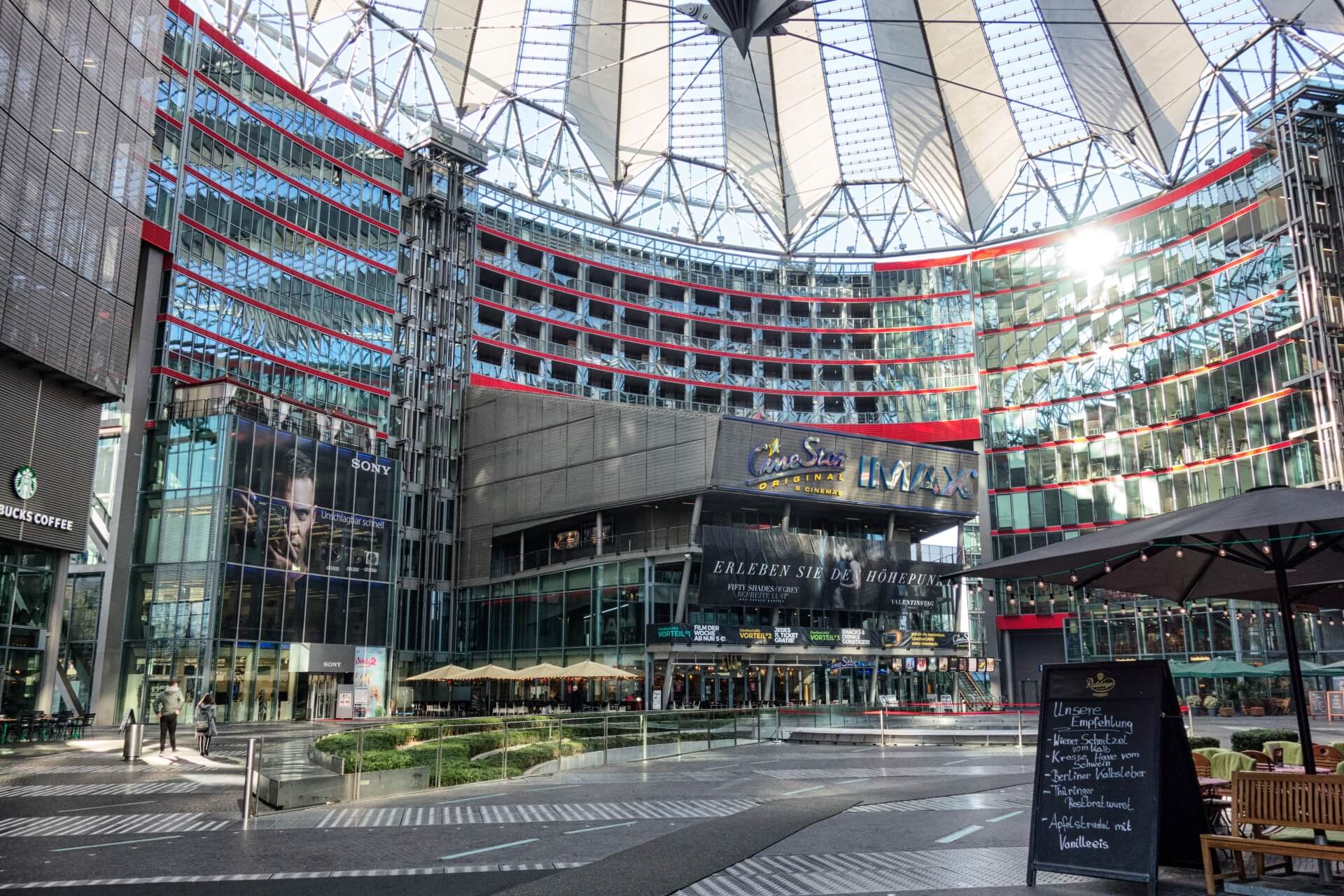
One of the most visited sites on Potsdamer Platz is the Sony Center, located in the Tiergarten quarter. This complex of buildings was constructed using the most modern Japanese technologies. Over two years (1996-98), seven structures were built, followed by two years of installing a massive glass dome. The world-renowned architect Helmut Jahn oversaw this grand project. It cost €600 million to complete. At the center’s opening in 2000, 2,500 prominent politicians, public figures, and cultural personalities attended.
Everyone present was stunned by the scale and originality of the modern buildings. The Sony Center features an oval square surrounded by seven glass and steel buildings. The roof-dome, which unites all the buildings like a tent, symbolizes Japan’s sacred Mount Fuji. It is especially stunning in the evening, illuminated by colorful lights that change every 21 seconds. Nearly 8 million people visit the complex annually.
Cruise on the Spree and Landwehr Canal
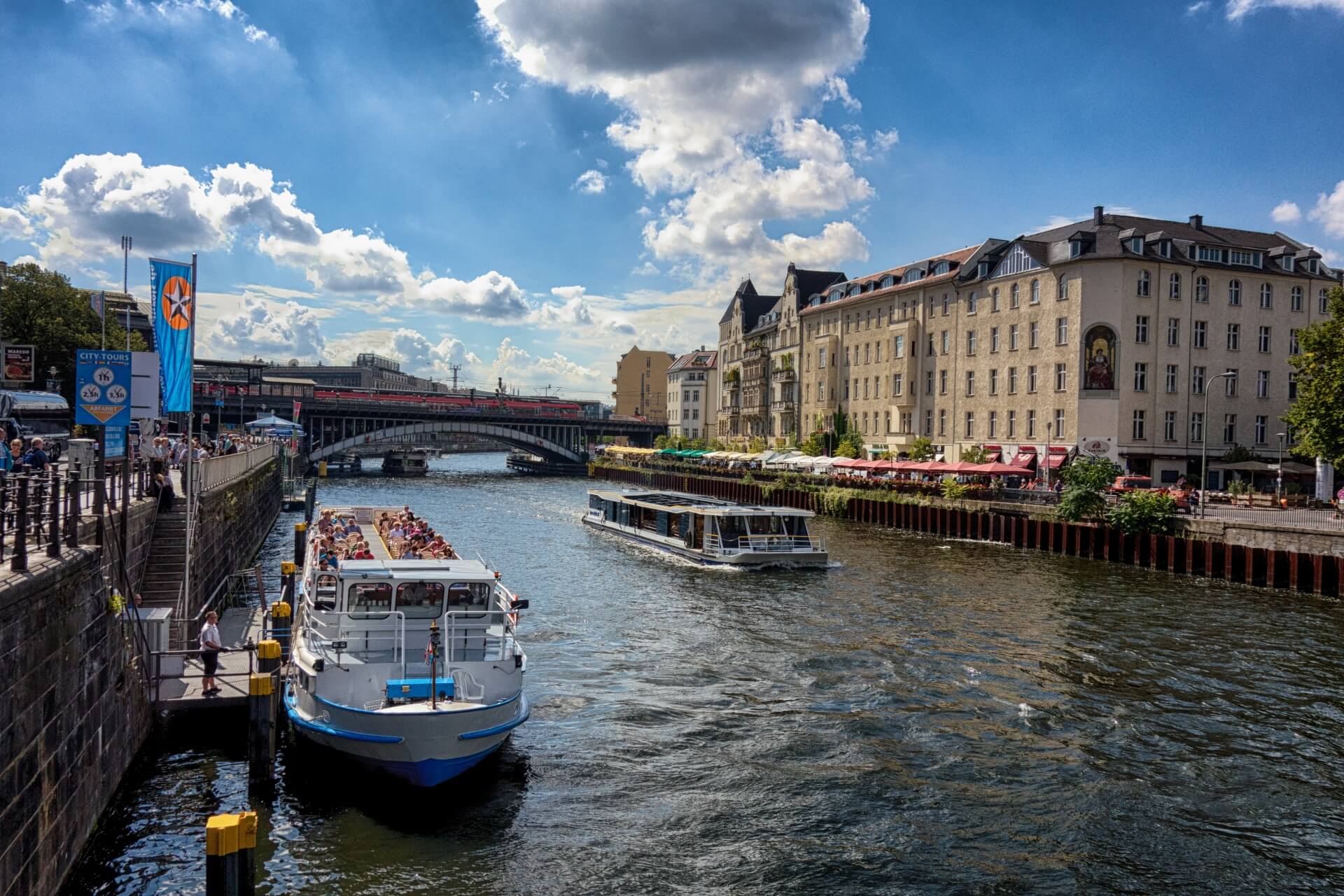
To conclude your second day, a delightful “highlight” of getting to know the city will be a four-hour cruise on the Spree and Landwehr Canal. During this time, you’ll see the city from a different perspective, admire the whimsical bridges (over 40) spanning the waterways, and marvel at the history of ancient crossings and super-modern bridge constructions. From the boat, you’ll glimpse the German Technical Museum, the Ministry of the Interior, and the beauty of Potsdamer Platz with its extraordinary buildings.
The picturesque panorama unfolding before your eyes will amaze and enhance your journey. During the cruise, you can use an audio guide in Russian, included in the cruise price. Complimentary drinks and snacks will be offered. You can add to your collection of trip photos and chat with tourists from other countries.
How to Get from the Airport to the City Center
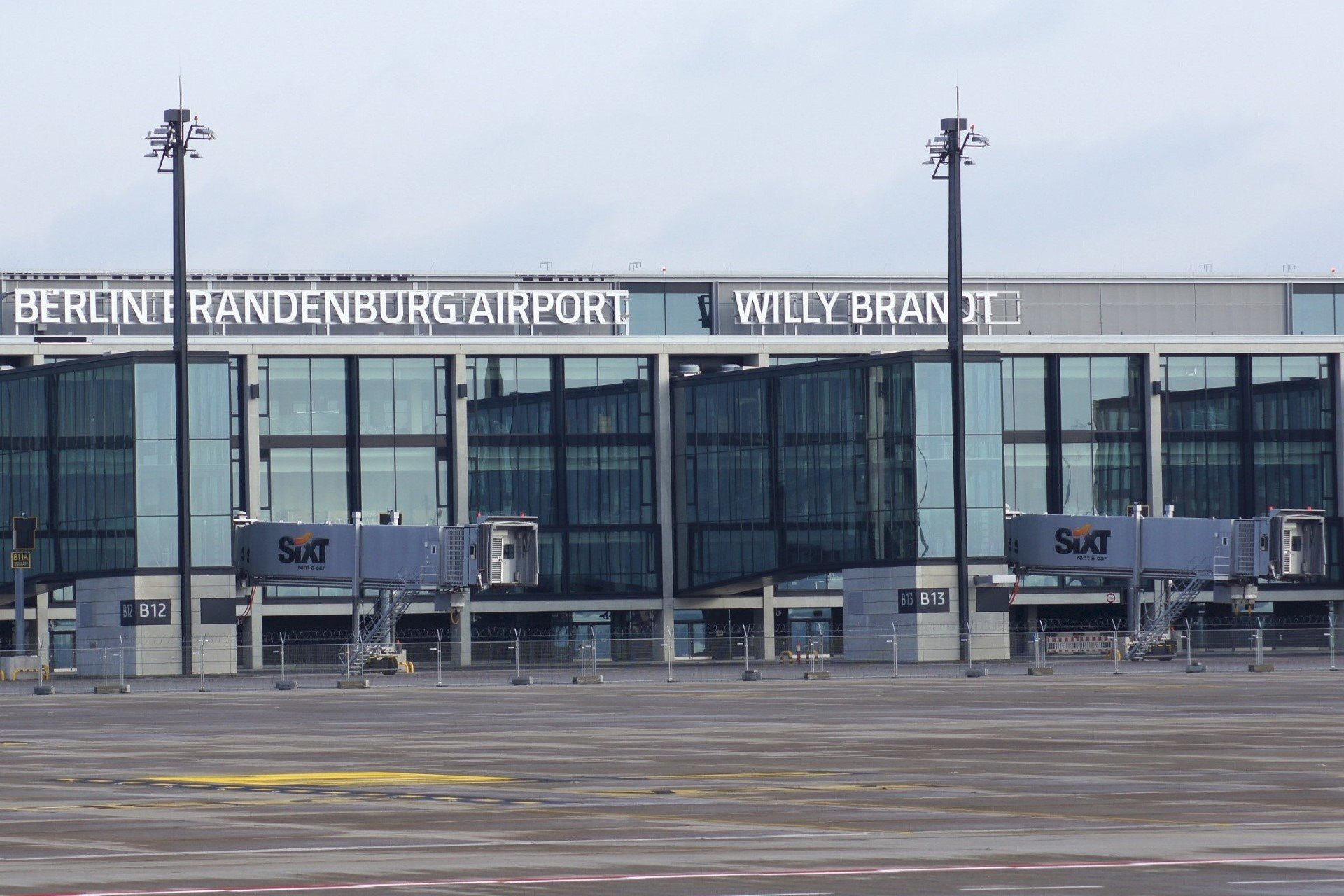
From Tegel Airport, you can reach the city center by all types of ground transportation:
Shuttles TXL and X9 are the most popular type of transportation, running from 5 AM to midnight. The ticket price is €2.70. Shuttle TXL stops at metro stations, taking 40 minutes. Shuttle X9 brings you to the Zoological Garden (the city center) in 20 minutes for €2.70.
Buses N109 and 128 run until late evening, every 15 minutes, with a travel time of 30-40 minutes. The ticket price is €2.70. They arrive at the metro station, from where you can reach any destination.
Taxis can be ordered if the plane lands at night and no pre-booked transfer is available. Travel time is 15-20 minutes, costing €50, so it’s worth finding fellow travelers to save money.

